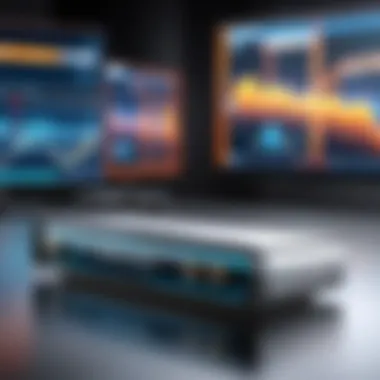Ultra Wideband Bluetooth: Transforming Wireless Tech


Intro
As wireless technology continues to evolve, the demand for faster and more reliable connectivity is paramount. Among the innovations making waves in this arena is Ultra Wideband (UWB) Bluetooth technology. This article delves into the nuances of UWB, particularly its integration with Bluetooth applications. The aim is to elucidate how this advancement is transforming connectivity, significantly enhancing user experience in various industries, from consumer electronics to automotive sectors.
With a focus on practical implications, this discourse will present the benefits of UWB, the challenges faced, and a look into future trends. Understanding UWB's capabilities is essential for tech-savvy individuals navigating this rapidly changing landscape.
Product Overview
Ultra Wideband technology stands apart from traditional Bluetooth by offering distinct advantages. UWB functions by transmitting data across a broad spectrum of frequencies, allowing for greater precision in distance measurement and data transfer. This capability lends itself well to a myriad of applications, including location tracking and high-speed data transfer.
Specifications
UWB operates on the frequency range of 3.1 to 10.6 GHz, which is significantly wider than conventional Bluetooth. This broad range not only allows better signal clarity but also minimizes interference, making connections more reliable.
Design
Devices that incorporate UWB technology are often designed with compactness and functionality in mind. Manufacturers like Apple and Samsung have already integrated UWB within their latest models, such as iPhone 13 and Galaxy Note 20. This integration reflects a shift towards more sophisticated wireless communication systems.
Features
- Precise Location Tracking: UWB enables accurate positioning within centimeters, surpassing GPS and traditional Bluetooth capabilities.
- High Data Transmission Rates: UWB can achieve data speeds of up to 480 Mbps, which is conducive for streaming high-quality audio or video.
- Lower Power Consumption: UWB devices are designed to consume less power compared to their predecessors, enhancing battery life.
Pricing
Prices for UWB-enabled devices can vary depending on the brand and features. However, as the technology proliferates, costs are expected to decrease. Generally, UWB technology is expected to be included in the pricing of premium devices, reflecting its advanced capabilities and applications.
Performance and User Experience
The performance of UWB in Bluetooth applications is outstanding, characterized by speed, efficiency, and user satisfaction.
Speed
In terms of speed, UWB outpaces traditional Bluetooth considerably. This allows for quicker file transfers and reduced latency in communication, critical in high-demand environments like gaming or streaming.
Battery Life
UWB is engineered to consume minimal power, which translates into extended battery life for devices. This feature is particularly useful in smart home gadgets that require persistent connectivity yet have space constraints for batteries.
User Interface
Interfacing with UWB devices tends to be seamless. With manufacturers focusing on making technology user-friendly, most UWB-enabled devices offer intuitive interfaces, making it easy for users to access and control functionalities.
Customization Options
Customization options vary widely, depending on the device and platform. Many manufacturers are providing users with the tools to personalize their settings, enhancing overall satisfaction.
Comparison with Similar Products
When comparing UWB with traditional Bluetooth technology, the differences become apparent.
Key Differences
- Range and Accuracy: UWB offers fine-grained location data, while traditional Bluetooth has a limited range with less precision.
- Data Rate: UWB significantly boosts data transfer speeds compared to older Bluetooth versions.
Value for Money
While UWB-enabled devices may appear more expensive upfront, the value they provide through improved functionality and versatility often outweighs the initial cost. Over time, users may find that the capabilities justify the investment.
Expert Recommendations


Best Use Cases
UWB technology shines in applications that demand high accuracy and speed, such as:
- Smart Home Solutions: For seamless communication among devices.
- Automotive Systems: Enhancing vehicle connectivity and safety features.
- Consumer Electronics: Offering robust data transfer capabilities.
Target Audience
The ideal audience for UWB technology includes tech enthusiasts, consumers seeking advanced features in their devices, and industries focused on innovation.
Final Verdict
Ultimately, Ultra Wideband Bluetooth technology is on the brink of revolutionizing various sectors. Its advantages over traditional methods position it as a leading candidate for future developments in wireless connectivity. By understanding its applications and benefits, users can make informed decisions, ensuring they remain at the forefront of technological advancement.
Preamble to Ultra Wideband Bluetooth
Ultra Wideband (UWB) Bluetooth represents a significant advancement in the field of wireless communication. As the demand for faster, more reliable, and precise connectivity continues to rise, understanding UWB's role in enhancing Bluetooth technology becomes crucial. This section serves as a gateway to exploring how UWB functionality can transform the user experience across various applications.
The importance of UWB lies in its ability to enable high precision location tracking and fast data transmission. Unlike traditional Bluetooth, UWB operates over a wider frequency spectrum, allowing for more detailed and accurate data transfer. Some key benefits to focus on include:
- Enhanced accuracy in locating devices, which is valuable in various fields such as healthcare and automotive.
- Reduced interference from other wireless technologies, ensuring a stable connection in densely populated areas.
- The potential for higher data rates, enabling the transmission of larger amounts of data more swiftly.
Understanding the fundamentals of UWB Bluetooth is essential for engaging with the future of wireless technology. Its integration into existing Bluetooth frameworks not only enhances performance but also opens doors for innovative applications that can reshape industries. The comprehensive exploration of UWB Bluetooth's characteristics and benefits will illustrate its pivotal role in both consumer electronics and broader technological landscapes.
Definition of Ultra Wideband Technology
Ultra Wideband technology refers to a wireless communication method that utilizes a broad range of frequencies to transmit data. While traditional Bluetooth typically operates within a limited frequency band, UWB spans from 3.1 to 10.6 GHz, allowing it to send signals over much wider bandwidths. This characteristic enhances its ability to achieve greater precision and reduce latency during data transmission.
UWB is known for its capability to deliver highly accurate distance measurements and location tracking. The signals emitted can discern minuscule variations in time, enabling precise triangulation of devices. This has significant implications in various sectors, especially where exact positioning is critical, like in medical devices or automotive navigation systems.
Overview of Bluetooth Technology
Bluetooth technology is a wireless communication standard that facilitates data exchange between devices over short distances using radio waves. It was developed to replace wired connections between devices, and it has become ubiquitous in everyday life. Bluetooth operates primarily in the 2.4 GHz ISM band, which, although effective for basic connectivity, can lead to congestion and reduced performance when many devices are in close proximity.
Bluetooth-enabled devices can communicate with one another through an established protocol that ensures secure, low-power data transfer. The evolution of Bluetooth has seen various iterations, improving data rates and range. However, limitations still exist when it comes to accuracy and speed, driving the necessity for innovations like UWB.
By understanding the foundation of Bluetooth technology and the principles underlying Ultra Wideband, we can better appreciate the transformative potential of integrating these two powerful tools.
Technical Aspects of UWB
The technical aspects of Ultra Wideband (UWB) shine a light on its foundational mechanisms and essential features. Understanding these elements is important for comprehending how UWB enhances connectivity, especially when paired with Bluetooth technology. UWB can offer significant advancements in communication techniques. Its merit lies in high data rates, accuracy, and minimal interference. Therefore, it is crucial to examine how it operates and what makes its signal characteristics distinct.
How UWB Works
Ultra Wideband technology operates by transmitting signals over a wide spectrum of frequencies, typically ranging from 3.1 to 10.6 GHz. This broad bandwidth makes it possible for UWB to encode data in a way that requires less power than other radio frequency technologies. Unlike traditional Bluetooth that typically utilizes narrow-band frequency modulation, UWB takes advantage of the high frequency to send multiple bits of data simultaneously, resulting in faster transmission speeds.
Moreover, UWB employs short pulses of energy instead of continuous waves. This characteristic enables precise time measurement and location tracking. Each pulse lasts only a fraction of a nanosecond, which enhances its ability to determine distances accurately. This is accomplished using Time of Flight (ToF) techniques, allowing devices to calculate distance by measuring the time it takes for a pulse to travel to an object and back.
Signal Characteristics of UWB
The signal characteristics of Ultra Wideband are critical for its effective function. These characteristics include its ability to maintain high levels of data integrity while minimizing interference.
- Broad Frequency Range: UWB signals cover a wide range of frequencies, enhancing the capacity to transmit large amounts of data over a short time frame. This minimizes congestion issues found in narrower bandwidth systems.
- Low Power Consumption: As UWB uses short pulses, it requires less energy to transmit signals, making it energy-efficient. This feature is particularly advantageous for battery-powered devices.
- Resistance to Interference: UWB's signal strength diminishes quickly with distance, which helps to prevent interference from other wireless signals. This ensures that UWB can operate effectively in environments filled with various radio signals, such as urban settings.
In summary, the technical aspects of UWB underscore the technology's ability to facilitate more reliable and efficient wireless communication. By leveraging its unique operational mechanics and favorable signal characteristics, UWB contributes significantly to the enhancement of Bluetooth technology. This integration promises a future where connectivity is not just fast but also accurate and robust.
The Marriage of UWB and Bluetooth
The integration of Ultra Wideband (UWB) technology with Bluetooth marks a significant evolution in wireless connectivity. UWB offers a unique blend of features that enhance the capabilities of traditional Bluetooth. This marriage allows for improved data transmission rates, precise location tracking, and greater resistance to interference. Understanding this integration is essential for grasping the full potential of modern wireless applications.
Integration Scenarios


The integration of UWB into Bluetooth systems opens up a variety of scenarios that benefit users in everyday situations. For instance, consider the context of smart home devices. By employing UWB technology, smart locks can not only facilitate easy unlocking through Bluetooth pairing but also ensure that the user is within a specific proximity before granting access. This setup increases security while enhancing user convenience.
Other examples include automotive applications where UWB-enabled Bluetooth can provide accurate keyless entry and location tracking for vehicles. A driver can unlock their car simply by being in range, and their precise location can facilitate more efficient navigation and parking solutions. Additionally, in personal device tracking, UWB technology can improve the functionality of finders like Apple's AirTag and Samsung's SmartTag, allowing users to locate items with pinpoint accuracy.
Comparative Analysis with Traditional Bluetooth
When comparing UWB Bluetooth to traditional Bluetooth, several key differences emerge. First, the precision in location tracking is vastly superior with UWB. Traditional Bluetooth generally operates within a range of about 30 feet, whereas UWB can pinpoint a device’s location to within centimeters. This accuracy is crucial in applications like augmented reality and precision asset tracking in warehouses.
Second, UWB offers significantly higher data transmission rates over short distances. While traditional Bluetooth speeds may be adequate for simple tasks like streaming audio, UWB can handle more demanding applications. This higher capacity is particularly advantageous for high-definition video transfers or large file synchronizations in environments like office or multimedia settings.
"The synergy of UWB and Bluetooth can transform user experiences, making them more seamless and efficient."
Lastly, the interference resistance of UWB technology provides a notable advantage over traditional Bluetooth. With UWB operating across a wide frequency spectrum, it can better avoid interference from other wireless devices. This makes UWB Bluetooth particularly effective in crowded environments where multiple wireless signals compete for clarity.
Advantages of Ultra Wideband Bluetooth
The integration of Ultra Wideband (UWB) technology into Bluetooth systems presents substantial advantages. These benefits not only elevate user experiences but also redefine functionalities across various applications. UWB's unique characteristics allow for more advanced uses of Bluetooth, focusing on areas like precision tracking, resistance to interference, and enhanced data rates. Each aspect serves to enhance connectivity and interaction in increasingly complex technological environments.
High Precision Location Tracking
One of the standout features of Ultra Wideband Bluetooth is high precision location tracking. Using time-of-flight measurements, UWB can determine distances with impressive accuracy. Traditional Bluetooth devices rely on signal strength, which can lead to inaccuracies caused by physical obstacles or signal reflections.
With UWB, the location accuracy can be within centimeters. This is especially beneficial in contexts such as indoor navigation and asset tracking. For example, in a smart home setup, one can accurately locate devices or users within the environment, making automation smarter and more responsive. The precision can enable applications in retail environments as well, providing detailed information about customer movement patterns.
"UWB’s precision location tracking capabilities may very well change how we interact with digital spaces, enhancing user engagement and efficiency."
Interference Resistance
A significant challenge in wireless communication is signal interference, which can disrupt device performance. Traditional Bluetooth technology can suffer from degradation in environments crowded with other Bluetooth devices or Wi-Fi signals. However, the characteristics of UWB provide robustness against such interference.
UWB operates over a wider frequency range, allowing it to avoid narrowing frequency bands that are often heavily utilized. This can keep connections more stable and reliable. In busy environments like offices or busy urban centers, this interference resistance proves invaluable. Devices equipped with UWB technology can maintain connections and improve overall user experience.
Increased Data Transmission Rates
Another compelling advantage of Ultra Wideband Bluetooth is its ability to transmit data at higher rates. UWB can theoretically offer speeds exceeding 1 Gbps, which is a marked improvement over the standard Bluetooth data rates.
Enhanced data transmission rates facilitate more seamless interactions when transferring large files or streaming high-quality media. Imagine transferring high-definition videos or large documents in mere seconds rather than waiting for minutes. As consumer electronics and smart devices continue to evolve, the demand for quick and efficient file sharing will increase, making UWB an important player in the future of connectivity.
In summary, the advantages of Ultra Wideband Bluetooth, such as high precision location tracking, robust interference resistance, and increased data transmission rates, position it as a transformative technology in the evolving landscape of wireless connectivity.
Challenges and Limitations of UWB
Exploring the challenges and limitations of Ultra Wideband (UWB) technology is essential in understanding its role within Bluetooth applications. While UWB offers notable advantages, it is not without its obstacles. Analyzing these challenges provides insights that can help developers and users mitigate potential drawbacks and make informed decisions going forward. This section will examine two critical areas: signal range considerations and device compatibility issues.
Signal Range Considerations
UWB technology operates over a wide frequency spectrum, which can make it susceptible to range limitations. The signal's ability to maintain integrity over distances is crucial in ensuring effective communication between devices. UWB is designed for short-range communication, typically within 10 to 30 meters, depending on the environment and obstacles. This limitation can pose issues in larger spaces or through barriers that block or attenuate the signal.
In real-world applications, such as smart homes or automotive settings, the effective range of UWB must be considered when designing systems. Factors like walls or interference from other electronic devices can negatively impact performance. The signal may degrade, leading to reduced accuracy and reliability in connections. As such, proper placement of UWB transmitters and receivers is vital to maximize operational range.
"Understanding signal range is crucial for optimizing the performance of UWB devices in various environments."
Device Compatibility Issues
Device compatibility represents another significant challenge for UWB integration within Bluetooth environments. As user demand increases for UWB technology, not all existing devices support this feature. Many smartphones, wearables, and other connected devices still rely on traditional Bluetooth technology, which may not fully utilize UWB's capabilities.
Moreover, the adoption of UWB is relatively new compared to standard Bluetooth technologies. As a result, manufacturers may face challenges in ensuring that UWB-enabled devices can effectively communicate with older Bluetooth-only devices. This could lead to fragmentation in the market and could hinder widespread acceptance of UWB solutions.
Therefore, when considering UWB implementations, device compatibility must be taken into account. Manufacturers should prioritize creating backward-compatible devices or solutions that bridge the gap between UWB and traditional Bluetooth technologies. This includes software updates or hybrid solutions that support both protocols, enabling a smoother transition for consumers as UWB gains traction.
In summary, while UWB technology Enhances connectivity capabilities, it is vital to consider the challenges related to signal range and device compatibility. Awareness and proactive measures can help navigate these obstacles, ensuring that the potential benefits of UWB are realized in real-world applications.


Applications of UWB Bluetooth Technology
The integration of Ultra Wideband (UWB) technology within Bluetooth devices is ushering in a new era of connectivity. This section explores the multifaceted applications of UWB Bluetooth technology across various sectors. Understanding these applications is pivotal, as it highlights the benefits and opportunities that UWB presents.
Consumer Electronics
Consumer electronics have greatly benefited from UWB Bluetooth technology. UWB enhances device performance by providing precise location tracking and higher data transfer rates. For instance, smartphones equipped with UWB can unlock doors and connect to devices with a simple approach.
With UWB, the experience becomes seamless. Users can locate their lost devices efficiently thanks to high precision. This is particularly advantageous for products like headphones and smartwatches, which can often be misplaced. The rapid data transmission inherent in UWB Bluetooth also enables smoother streaming and faster file transfers, greatly improving user satisfaction in everyday electronic interactions.
Automotive Industry
Within the automotive industry, UWB technology has the potential to redefine in-car connectivity and security. Vehicles utilizing UWB can detect the exact position of smart keys. This feature allows for keyless entry as well as theft prevention. UWB-enabled cars can recognize the presence of the driver, enhancing safety features and personalizing user experience.
Also, as cars become increasingly connected, UWB will facilitate communication between vehicles and surrounding infrastructure. This technology can help transfer data regarding traffic conditions, thus aiding in navigation and traffic management. The automotive sector, therefore, stands to gain significantly from implementing UWB Bluetooth solutions.
Smart Home Solutions
Smart homes are increasingly becoming standardized with intelligent systems that enhance everyday life. UWB Bluetooth plays a key role in enabling efficient connections between various smart devices. Home automation systems benefit from UWB's low latency, allowing for quick responses in smart lighting and climate control.
Additionally, the potential for location-based services within the home is significant. For example, a UWB-enabled smart speaker could adjust its volume based on the distance of a person from it. This ensures that the user experience is both personalized and intuitive. As smart home solutions continue to evolve, leveraging UWB technology will be crucial in realizing more integrated and responsive systems.
Healthcare Innovations
The healthcare industry is another sector where UWB Bluetooth technology can make a notable impact. UWB enables accurate tracking of medical equipment and personnel within hospitals. This increased efficiency helps reduce costs and improve patient care by ensuring that essential tools are readily available when needed.
Moreover, wearable health devices can utilize UWB to monitor patients with remarkable precision. Data collected from these devices can enhance treatment plans and assist in timely medical interventions. As healthcare systems continuously strive for improvement, UWB technology presents an opportunity for advancements in patient monitoring and resource management.
In summary, the applications of UWB Bluetooth technology span various sectors. Its impact on consumer electronics, automotive, smart homes, and healthcare reveals significant benefits. As industries adapt to these changes, the adoption of UWB will likely continue to grow, signaling a new chapter in the evolution of connectivity.
Future Prospects of UWB in Bluetooth Devices
The integration of Ultra Wideband (UWB) technology into Bluetooth devices signifies a crucial turning point in wireless connectivity. As industries adapt to meet changing consumer needs, UWB emerges not merely as an enhancement but as a transformative force. The future of UWB in Bluetooth devices is essential to understand for anyone interested in the evolution of technology.
Predicted Trends in Technology Adoption
UWB technology is expected to see significant adoption in various sectors, driven by its unique capabilities. The following trends are noteworthy:
- Increased Demand in Consumer Electronics: As smart devices proliferate, the need for precise location tracking and faster data transmission will escalate. UWB can meet these demands effectively, making it a preferred choice over traditional Bluetooth protocols.
- Emergence in Automotive Solutions: UWB's capabilities for secure and accurate keyless entry systems in vehicles will likely accelerate its adoption in the automotive industry. Several manufacturers are already experimenting with this technology, envisioning enhanced user experiences.
- Smart Home Implementations: As smart home ecosystems grow, UWB-compatible devices may become mainstream. The ability to pinpoint device locations with accuracy poses significant advantages for home automation, enabling seamless integration and improved user control.
The predictions indicate a growing trend where both consumers and industries opt for UWB technology, driving innovation and standardization in wireless communication.
Impact on Market Dynamics
The integration of UWB into Bluetooth devices will inevitably alter market dynamics. A few important aspects to consider include:
- Competitive Landscape: Companies that embrace UWB will likely gain a competitive edge. As more devices include UWB technology, traditional Bluetooth solutions might become less favorable, compelling businesses to adapt swiftly.
- Partnership and Collaboration Growth: To maximize UWB's potential, collaborations among tech companies may increase. Pooling resources and expertise can lead to more robust solutions, influencing market strategies.
- Regulatory and Standardization Changes: The rise of UWB technology could prompt updates to regulatory frameworks as industry standards evolve. Organizations may need to adapt to a new set of guidelines focusing on UWB specifications, which can affect all layers of device connectivity.
"As more industry players invest in UWB, the roadmap for Bluetooth technology will undergo profound changes, steering it towards an era of unparalleled connectivity."
Culmination
The exploration of Ultra Wideband (UWB) technology's integration with Bluetooth has revealed significant implications for the future of wireless communication. As industries increasingly demand high-speed, reliable connectivity, this revolution is particularly pertinent. UWB's ability to support precise location tracking and its resistance to interference positions it as a formidable contender against traditional Bluetooth solutions.
Summary of Key Insights
- Enhanced Connectivity: UWB enhances Bluetooth by providing higher data rates and improved accuracy for device locating.
- Industry Applications: Its applications span various sectors, including consumer electronics, automotive, healthcare, and smart homes, showcasing its versatility.
- Challenges Ahead: Despite its advantages, challenges related to signal range and device compatibility must be addressed for widespread adoption.
"UWB technology is set to redefine our expectations of connectivity, paving the way for increasingly sophisticated applications."
- Future Trends: Predictions indicate a significant rise in UWB's integration in Bluetooth devices, influencing market dynamics and driving innovation in connectivity solutions.
Final Thoughts on UWB and Bluetooth Integration
As the demand for faster and more reliable wireless solutions becomes paramount, the integration of UWB with Bluetooth presents a transformative opportunity. The marriage of these technologies signifies a step towards smarter and more interconnected devices. Considering the benefits of UWB, it is evident that it will shape the future of connectivity. Stakeholders must prioritize understanding these developments as they unfold.
The shift from conventional Bluetooth to Ultra Wideband-enhanced systems will mark a new era in how we perceive and interact with technology. As innovators harness UWB's potential to improve connectivity, the tech landscape will continually evolve, demanding adaptation from both creators and users alike.







